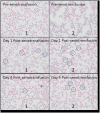Preliminary Investigation of Bovine Whole Blood Xenotransfusion as a Therapeutic Modality for the Treatment of Anemia in Goats
- PMID: 33748213
- PMCID: PMC7969644
- DOI: 10.3389/fvets.2021.637988
Preliminary Investigation of Bovine Whole Blood Xenotransfusion as a Therapeutic Modality for the Treatment of Anemia in Goats
Abstract
Anemia requiring whole blood transfusion for appropriate treatment is a common clinical presentation of caprine patients to veterinary practitioners; however, identifying suitable blood donors in goat herds can be challenging. In other veterinary species, the practice of xenotransfusion, where blood from 1 species is transfused to another, is used in emergency settings. Due to their ability to donate large volumes of whole blood, cattle could be an ideal source for xenotransfusion of goats. In this study 2 healthy goats were transfused with bovine whole blood. The goats were then monitored for adverse effects and the presence of bovine erythrocyte post-xenotransfusion. Afterward, 15 caprine-bovine combinations were evaluated for compatibility via cross-matching. Both goats tolerated xenotransfusion, although transient reactions were observed. Of the 15 cross-match combinations, 11 of the major cross matches were compatible, and all minor cross matches were also compatible. While future work is necessary to refine this technique, xenotransfusion of goats with cattle blood may be a therapeutic modality for the treatment of caprine anemia.
Keywords: anemia; blood transfusion; goat (Capra aegagrus hircus); transfusion; xenotransfusion.
Copyright © 2021 Smith, Viall, Breuer, Walton, Plummer, Griffith and Kreuder.
Conflict of interest statement
The authors declare that the research was conducted in the absence of any commercial or financial relationships that could be construed as a potential conflict of interest.
Figures
Similar articles
-
In vitro feasibility of bovine and canine whole blood and commercially prepared canine packed red blood cells as a source of xenotransfusion in swine (Sus scrofa domestica).PeerJ. 2025 May 9;13:e19436. doi: 10.7717/peerj.19436. eCollection 2025. PeerJ. 2025. PMID: 40356671 Free PMC article.
-
Xenotransfusion with packed bovine red blood cells to a wildebeest calf (Connochaetes taurinus).J S Afr Vet Assoc. 2018 Oct 17;89(0):e1-e6. doi: 10.4102/jsava.v89i0.1669. J S Afr Vet Assoc. 2018. PMID: 30326712 Free PMC article.
-
Retrospective study of canine blood xenotransfusion compared with type-matched feline blood allotransfusion to cats: indications, effectiveness, limitations and adverse effects.J Feline Med Surg. 2023 Jul;25(7):1098612X231183930. doi: 10.1177/1098612X231183930. J Feline Med Surg. 2023. PMID: 37466270 Free PMC article.
-
Xenotransfusion of canine blood to cats: a review of 49 cases and their outcome.J Small Anim Pract. 2020 Mar;61(3):156-162. doi: 10.1111/jsap.13096. Epub 2019 Dec 22. J Small Anim Pract. 2020. PMID: 31867733 Review.
-
Global Goat! Is the Expanding Goat Population an Important Reservoir of Cryptosporidium?Front Vet Sci. 2021 Mar 5;8:648500. doi: 10.3389/fvets.2021.648500. eCollection 2021. Front Vet Sci. 2021. PMID: 33748221 Free PMC article. Review.
Cited by
-
In vitro feasibility of bovine and canine whole blood and commercially prepared canine packed red blood cells as a source of xenotransfusion in swine (Sus scrofa domestica).PeerJ. 2025 May 9;13:e19436. doi: 10.7717/peerj.19436. eCollection 2025. PeerJ. 2025. PMID: 40356671 Free PMC article.
-
Presentation, Clinical Pathology Abnormalities, and Identification of Gastrointestinal Parasites in Camels (Camelus bactrianus and Camelus dromedarius) Presenting to Two North American Veterinary Teaching Hospitals. A Retrospective Study: 1980-2020.Front Vet Sci. 2021 Mar 22;8:651672. doi: 10.3389/fvets.2021.651672. eCollection 2021. Front Vet Sci. 2021. PMID: 33829053 Free PMC article.
-
Xenotransfusion of Blood from Dog to Cat: Should Canine Blood Be Our First Choice for Feline Transfusion in Emergency Situations?Vet Sci. 2022 Feb 28;9(3):106. doi: 10.3390/vetsci9030106. Vet Sci. 2022. PMID: 35324834 Free PMC article.
-
Failure of Passive Transfer in Camel Calves: 4 Cases (2010-2019).Case Rep Vet Med. 2022 Apr 23;2022:8182648. doi: 10.1155/2022/8182648. eCollection 2022. Case Rep Vet Med. 2022. PMID: 35502448 Free PMC article.
References
-
- Triulzi DJ, Kleinman S, Kakaiya RM, Busch MP, Norris PJ, Steele WR, et al. . The effect of previous pregnancy and transfusion on HLA alloimmunization in blood donors: implications for a transfusion-related acute lung injury risk reduction strategy. Transfusion. (2009) 49:1825–35. 10.1111/j.1537-2995.2009.02206.x - DOI - PMC - PubMed
LinkOut - more resources
Full Text Sources
Other Literature Sources


